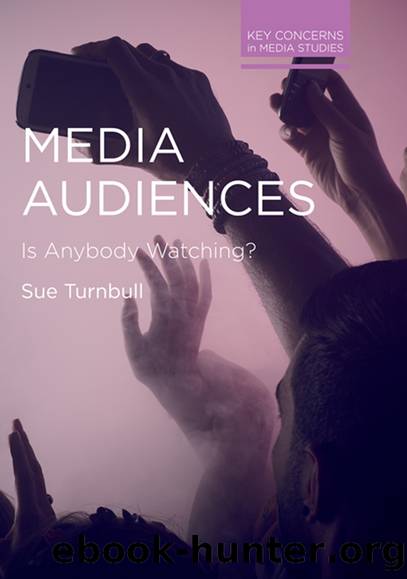Media Audiences by Sue Turnbull

Author:Sue Turnbull [Turnbull, Sue]
Language: eng
Format: epub
Tags: Social Science, Media Studies
ISBN: 9781137405111
Google: t8fgDwAAQBAJ
Publisher: Red Globe Press
Published: 2020-05-01T04:23:13+00:00
A question of morality
For the moral campaigners of the 1920s who initiated the series of research projects known as the Payne Fund Studies, the representation of sexuality was a major concern, not to mention the potential dangers of congregation in the dark. Given the popularity of the movie theatres amongst young people, it was imagined that these images would also be having a profound effect on young people. As noted in Chapter 2, this inspired all kinds of inventive research methods to try and capture these potential effects, from psychogalvanic skin measures, to the collection of hundreds of individual biographies (Jowett et al., 1996, p. 81). While the Payne Fund Studies were by and large concerned with sexual matters, the other moral concern that would preoccupy media audience research from the 1960s onwards was the depiction of violence. Although this anxiety began with a concern about screen violence in film, it subsequently extended to television and video and thence to the home computer and the playing of video games. Echoing the use of psychogalvanic skin measures employed in the Payne Fund Studies, elaborate experiments were conducted by social psychologists in laboratory-type situations, often involving their own students, to test the kinds of effects that these games might produce. However, in a review of the audience research on âviolent video gamesâ (conducted in 2010 for the Attorney Generalâs Department in Australia), the authors argue that many of these studies were problematic because they included âcontested definitions and measuresâ both of what is understood by the term âaggressionâ as well as the category âviolent video gameâ. For example, are sports games more or less violent and aggressive than games which feature fictional or real wars?
Another problem with this laboratory-type research was the fact that it often failed to consider in any depth other variables, including race, ethnicity, gender and other contextual factors. Indeed, as has been observed by many, there was a consistent bias in that the participants were often university students, who may not be typical of the game-playing population as a whole. Another issue had to do with the ways in which increased aggression may be measured using what are described as âproxiesâ for aggressive behaviours â such as ânoise blastsâ, which are hardly indicative of how people might respond to frustrating incidents in real-life situations. The authors of this comprehensive survey therefore end with the kind of non-conclusive paragraph that is typical of attempts to review the literature on media effects:
Significant harmful effects from Violent Video Games (VVG) have not been persuasively proven or disproven. There is some consensus that VVGs may be harmful to certain populations, such as people with aggressive and psychotic personality traits. Overall most studies have consistently shown a small statistical effect of VVG exposure on aggressive behaviour, but there are problems with these findings that reduce their policy relevance. Overall, as illustrated in this review, research into the effects of VVGs on aggression is contested and inconclusive.
(Attorney Generalâs Department, 2010, p. 42)
Download
This site does not store any files on its server. We only index and link to content provided by other sites. Please contact the content providers to delete copyright contents if any and email us, we'll remove relevant links or contents immediately.
Index to the London Magazine by Frank P. Riga Claude A. Prance(188)
Female Impersonation by Carol-Anne Tyler(135)
Creativity and Feature Writing by Ellie Levenson(122)
A Filtered Life by Nicole Taylor Mimi Nichter(119)
Xenolinguistics; Towards a Science of Extraterrestrial Language by Douglas A. Vakoch & Jeffrey Punske(116)
Theories of Journalism in a Digital Age by Steen Steensen Laura Ahva(114)
Critical Communication Pedagogy by Fassett Deanna L.;Warren John T.; & John T. warren(109)
Torture, Intelligence and Sousveillance in the War on Terror by Vian Bakir(108)
Origin Of Ethnography In Japan by Minoru Kawada(105)
Developing Translanguaging Repertoires in Critical Teacher Education by Zhongfeng Tian Nicole King(105)
Computing the News: Data Journalism and the Search for Objectivity by Sylvain Parasie(102)
Peace Journalism in East Africa by Fredrick Ogenga(100)
Transformative Media Pedagogies by Paul Mihailidis Sangita Shresthova Megan Fromm(99)
Matter Transmission by Nicolás Salazar Sutil(94)
A Networked Self and Platforms, Stories, Connections by Zizi Papacharissi(91)
Media Studies 2.0 by William Merrin(91)
Media Audiences by Sue Turnbull(91)
Revisiting Transnational Broadcasting by Nelson Ribeiro Stephanie Seul(90)
The Gentrification of the Internet by Jessa Lingel(88)
